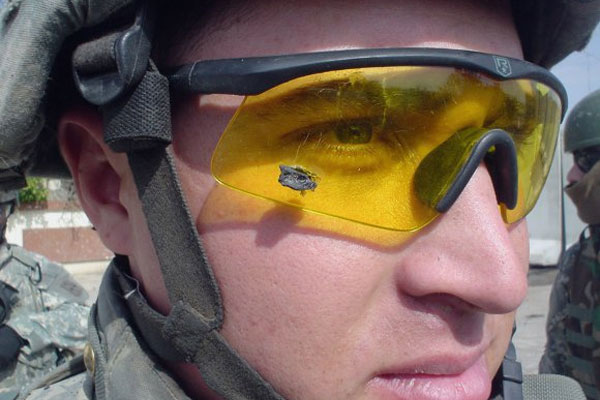

Prescription eyewear meeting the above standard is marked with Z87-2+. The pass/fail for the high-velocity test is the same as for the high mass test, with the added requirement that no part of the lens may touch the “eye” on the head form. In the high-velocity test, a 0.25-inch (0.635 cm) steel ball is shot at the lens on the head form at 150 fps (45.72 m/s).
ARMY EYE PRO FREE
No pieces from the frames or lenses may break free or fracture. In the high mass test, a 500-gram (17.6 oz) pointed weight is dropped from a height of 50 inches (127 cm) onto the lenses mounted on a head form.

There are two main tests for Z87+: high mass and high velocity. Z87+ means that the eyewear meets a higher impact standard and goes through a stricter set of tests than the basic Z87 standard. Starting with ANSI Z87.1-2010, the distinction now is either non-impact or impact rated.ĪNSI/ISEA impact-rated eyewear carries the Z87+ mark on the lens and the frame or housing. Previously, protective eyewear was classified as either basic or high impact. The 2010 revision began a shift towards being more hazards based. The 2020 edition of ANSI/ISEA Z87.1 is the second revision since 2010. ISEA (International Safety Equipment Association) is an ANSI accredited standards developing organization for personal protective equipment (PPE) and technologies. The current ANSI Z87.1 Standard is ANSI/ISEA Z87.1-2020. Compliance with this standard is also voluntary. The standard provides criteria and requirements for selection, use, and maintenance of the different face and eye protectors to promote the most effective materials and methods of use. The ANSI Z87.1 Standard is designed to help eliminate eye and face hazards in occupational and educational settings. It does scratch fairly easily and requires a scratch-resistant coating for durability. Polycarbonate inherently blocks nearly 100% of UV, blocking wavelengths up to 400nm (UV400 protection). Polycarbonate lenses have excellent optical clarity, although they can’t match glass lenses in this regard. They’re lighter and thinner than glass or plastic lenses and have from 10 to 20 times more impact resistance. Polycarbonate lenses are the most impact-resistant lenses available. Polycarbonate is 300-times stronger than single-strength glass and significantly tougher than other transparent sheet materials of equal thickness Photo: US Marine Corps photo by Staff Sgt.

The cockpit canopy of the Lockhead Marin F22 jet fighter is made from a piece of high optical quality polycarbonate. In the study, tennis balls propelled at 40 mph shattered high-index plastic lenses, while balls at 55 mph broke allyl resin (also known as hard resin or CR-39) plastic lenses, and those at 89 mph shattered glass lenses. Vinger conducted a study involving 350 impact tests on various types of glasses published in the Jissue of JAMA: The Journal of the American Medical Association1. Vinger, an Associate Clinical Professor at Tufts Medical School in Medford, Massachusetts, most lenses shatter into fragments when hit by objects moving at easily reached speeds.ĭr. SHATTERING COMMON MYTHSįDA safety standards for sunglasses don’t provide the level of impact protection that’s essential for shooting or law enforcement, or even active sports. The current ANSI Z80.3 Standard is ANSI Z80.3-2018.ĪNSI Z80.3 standard addresses ultraviolet (UV) protection, including elements such as light transmittance, including the wearer distinguishing between green and yellow light in average daylight. ANSI Z80.3 includes standards for impact resistance, flammability, bio-compatibility, and optical properties. Compliance with the voluntary American National Standards Institute (ANSI) Z80.3 standard is considered acceptable.ĪNSI Z80.3 establishes standard guidelines for “noncorrective (essentially Plano power) lenses that are intended for attenuation of light and for fashion eyewear,” commonly known as sunglasses. They’re required to conform to basic safety standards. The Food and Drug Administration (FDA) regulates non-prescription sunglasses sold, in the US, as Class 1 medical devices. 6, 2006 photo, 1LT Anthony Aguilar wears the ballistic protective eyewear that prevented a bomb fragment from possibly damaging his eyes when an improvised explosive device detonated near his Stryker vehicle while on patrol.


 0 kommentar(er)
0 kommentar(er)
